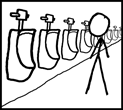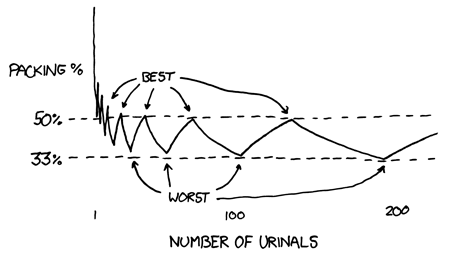 When a guy goes into the bathroom, which urinal does he pick? Most guys are familiar with the International Choice of Urinal Protocol. It’s discussed at length elsewhere, but the basic premise is that the first guy picks an end urinal, and every subsequent guy chooses the urinal which puts him furthest from anyone else peeing. At least one buffer urinal is required between any two guys or Awkwardness ensues.
When a guy goes into the bathroom, which urinal does he pick? Most guys are familiar with the International Choice of Urinal Protocol. It’s discussed at length elsewhere, but the basic premise is that the first guy picks an end urinal, and every subsequent guy chooses the urinal which puts him furthest from anyone else peeing. At least one buffer urinal is required between any two guys or Awkwardness ensues.Let’s take a look at the efficiency of this protocol at slotting everyone into acceptable urinals. For some numbers of urinals, this protocol leads to efficient placement. If there are five urinals, they fill up like this:

On the other hand, if there are seven urinals, they don’t fill up so efficiently:

For eight urinals, the protocol works better:

This leads us to a question: what is the general formula for the number of guys who will fill in N urinals if they all come in one at a time and follow the urinal protocol? One could write a simple recursive program to solve it, placing one guy at a time, but there’s also a closed-form expression. If f(n) is the number of guys who can use n urinals, f(n) for n>2 is given by:



These calculations suggest a few other hacks. Guys: if you enter a bathroom with an awkward number of vacant urinals in a row, rather than taking one of the end ones, you can take one a third of the way down the line. This will break the awkward row into two optimal rows, turning a worst-case scenario into a best-case one. On the other hand, say you want to create awkwardness. If the bathroom has an unawkward number of urinals, you can pick one a third of the way in, transforming an optimal row into two awkward rows.
And, of course, if you want to make things really awkward, I suggest printing out this article and trying to explain it to the guy peeing next to you.
Discussion question: This is obviously a male-specific issue. Can you think of any female-specific experiences that could benefit from some mathematical analysis, experiences which — being a dude — I might be unfamiliar with? Alignments of periods with sequences of holidays? The patterns to those playground clapping rhymes? Whatever it is that goes on at slumber parties? Post your suggestions in the comments!
Edit: The protocol may not be international, but I’m calling it that anyway for acronym reasons.
No comments:
Post a Comment